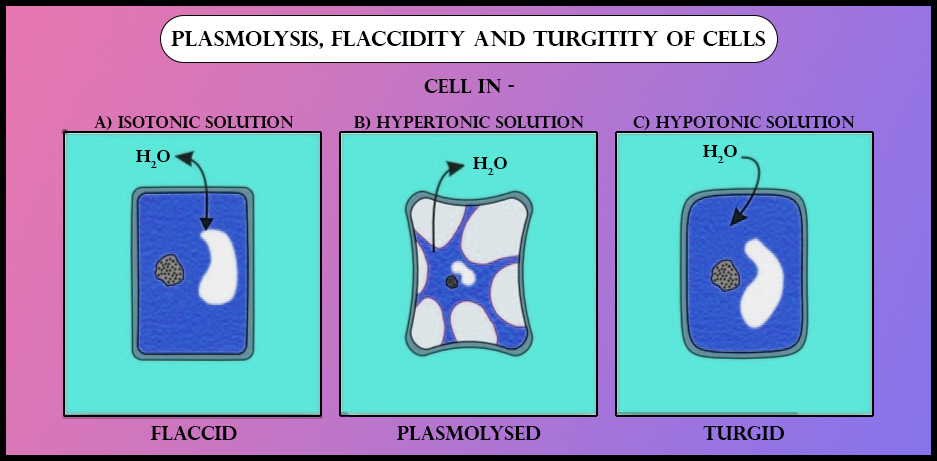
Turgor pressure of the plasmolyzed cell is
(a) Positive
(b) Zero
(c) Negative
(d) None of the above
Answer
554.1k+ views
Hint: The pressure against the cell wall due to the fluid is called turgor pressure, in a plasmolyzed cell plasma membrane shrinks from the cell wall.
Complete answer:
> When the water moves out of the cell, the cell and cell membrane of the plant shrinks away from the cell wall resulting in plasmolysis. This process is usually reversible. When a cell is placed in a hypotonic solution the water from the surrounding enters into the cell resulting in pressure buildup against the cell wall.

> This pressure is called turgor pressure. In a cell placed in the hypertonic solution the cell membrane shrinks and no pressure buildup against the cell wall. So the turgor pressure is zero.
Additional information:
- When the water is drawn out of the cell through diffusion into the extracellular fluid causes the protoplast to shrink away from the cell wall. If the plasma membrane shrinks away only from the cell wall corners, it is called incipient plasmolysis. If this cell is placed in a hypertonic solution for a long time, then the cell becomes completely plasmolyzed.
- In a completely plasmolyzed cell, the solute potential is equal to the water potential and the pressure against the cell wall is zero.
- This pressure against the cell wall is called turgor pressure.
So, the correct answer is ‘(b) Zero’
Note:
> Some of the applications of plasmolysis are, it is used in the salting of meat, fish, and pickles. When they are plasmolyzed, water content inside the cell will be very low so the chances of attacking pathogens like bacteria are low.
> In a cell placed in a hypotonic solution, turgor pressure is positive.
Complete answer:
> When the water moves out of the cell, the cell and cell membrane of the plant shrinks away from the cell wall resulting in plasmolysis. This process is usually reversible. When a cell is placed in a hypotonic solution the water from the surrounding enters into the cell resulting in pressure buildup against the cell wall.

> This pressure is called turgor pressure. In a cell placed in the hypertonic solution the cell membrane shrinks and no pressure buildup against the cell wall. So the turgor pressure is zero.
Additional information:
- When the water is drawn out of the cell through diffusion into the extracellular fluid causes the protoplast to shrink away from the cell wall. If the plasma membrane shrinks away only from the cell wall corners, it is called incipient plasmolysis. If this cell is placed in a hypertonic solution for a long time, then the cell becomes completely plasmolyzed.
- In a completely plasmolyzed cell, the solute potential is equal to the water potential and the pressure against the cell wall is zero.
- This pressure against the cell wall is called turgor pressure.
So, the correct answer is ‘(b) Zero’
Note:
> Some of the applications of plasmolysis are, it is used in the salting of meat, fish, and pickles. When they are plasmolyzed, water content inside the cell will be very low so the chances of attacking pathogens like bacteria are low.
> In a cell placed in a hypotonic solution, turgor pressure is positive.
Recently Updated Pages
Basicity of sulphurous acid and sulphuric acid are

Master Class 9 General Knowledge: Engaging Questions & Answers for Success

Master Class 9 English: Engaging Questions & Answers for Success

Master Class 9 Science: Engaging Questions & Answers for Success

Class 9 Question and Answer - Your Ultimate Solutions Guide

Master Class 12 Business Studies: Engaging Questions & Answers for Success

Trending doubts
What is meant by exothermic and endothermic reactions class 11 chemistry CBSE

Which animal has three hearts class 11 biology CBSE

10 examples of friction in our daily life

One Metric ton is equal to kg A 10000 B 1000 C 100 class 11 physics CBSE

1 Quintal is equal to a 110 kg b 10 kg c 100kg d 1000 class 11 physics CBSE

Difference Between Prokaryotic Cells and Eukaryotic Cells




